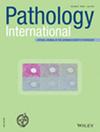在免疫检查点抑制剂诱导的肾小管间质性肾炎中,CD8+细胞浸润占主导地位,而调节性T细胞积累较少
IF 2.5
4区 医学
Q2 PATHOLOGY
引用次数: 0
摘要
免疫检查点抑制剂(ICIs)可为癌症患者带来生存益处,但有时也会导致肾脏免疫相关不良事件(irAEs)的发生。肾小管间质性肾炎(TIN)是肾脏免疫相关不良事件中最具代表性的病理特征。然而,ICI 诱导的 TIN 的临床病理实体和潜在发病机制尚不清楚。因此,我们比较了该病症与非 ICI 药物诱导的 TIN 的临床和组织学特征。ICI诱发的TIN患者年龄和C反应蛋白水平明显升高,但肾功能无明显差异。ICI 诱导的 TIN 的免疫分型显示大量 T 细胞和巨噬细胞浸润,B 细胞、浆细胞、中性粒细胞和嗜酸性粒细胞较少。与非ICI药物诱导的TIN相比,ICI诱导的TIN中CD4+细胞数量明显减少,但CD8+细胞数量无明显差异。但是,在 ICI 诱导的 TIN 中,CD8/CD3 和 CD8/CD4 比率较高。此外,在 ICI 诱导的 TIN 中,CD25+ 和 FOXP3+ 细胞(即调节性 T 细胞)的数量较少。总之,T细胞、B细胞、浆细胞、中性粒细胞和嗜酸性粒细胞的数量证明有助于区分ICI诱导的TIN和非ICI药物诱导的TIN。此外,CD8+细胞的主要分布和调节性T细胞的低积累可能与ICI诱导的TIN发展有关。本文章由计算机程序翻译,如有差异,请以英文原文为准。
Predominant CD8+ cell infiltration and low accumulation of regulatory T cells in immune checkpoint inhibitor‐induced tubulointerstitial nephritis
Immune checkpoint inhibitors (ICIs) can provide survival benefits to cancer patients; however, they sometimes result in the development of renal immune‐related adverse events (irAEs). Tubulointerstitial nephritis (TIN) is the most representative pathological feature of renal irAEs. However, the clinicopathological entity and underlying pathogenesis of ICI‐induced TIN are unclear. Therefore, we compared the clinical and histological features of this condition with those of non‐ICI drug‐induced TIN. Age and C‐reactive protein levels were significantly higher in ICI‐induced TIN, but there were no significant differences in renal function. Immunophenotyping of ICI‐induced TIN showed massive T cell and macrophage infiltration with fewer B cells, plasma cells, neutrophils, and eosinophils. Compared with those in non‐ICI drug‐induced TIN, CD4+ cell numbers were significantly lower in ICI‐induced TIN but CD8+ cell numbers were not significantly different. However, CD8/CD3 and CD8/CD4 ratios were higher in ICI‐induced TIN. Moreover, CD25+ and FOXP3+ cells, namely regulatory T cells, were less abundant in ICI‐induced TIN. In conclusion, T cell, B cell, plasma cell, neutrophil, and eosinophil numbers proved useful for differentiating ICI‐induced and non‐ICI drug‐induced TIN. Furthermore, the predominant distribution of CD8+ cells and low accumulation of regulatory T cells might be associated with ICI‐induced TIN development.
求助全文
通过发布文献求助,成功后即可免费获取论文全文。
去求助
来源期刊

Pathology International
医学-病理学
CiteScore
4.50
自引率
4.50%
发文量
102
审稿时长
12 months
期刊介绍:
Pathology International is the official English journal of the Japanese Society of Pathology, publishing articles of excellence in human and experimental pathology. The Journal focuses on the morphological study of the disease process and/or mechanisms. For human pathology, morphological investigation receives priority but manuscripts describing the result of any ancillary methods (cellular, chemical, immunological and molecular biological) that complement the morphology are accepted. Manuscript on experimental pathology that approach pathologenesis or mechanisms of disease processes are expected to report on the data obtained from models using cellular, biochemical, molecular biological, animal, immunological or other methods in conjunction with morphology. Manuscripts that report data on laboratory medicine (clinical pathology) without significant morphological contribution are not accepted.
 求助内容:
求助内容: 应助结果提醒方式:
应助结果提醒方式:


